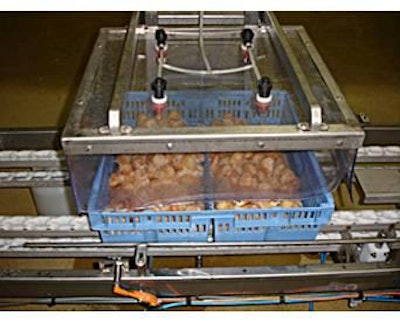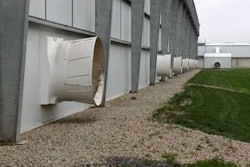
Choosing the right vaccine to protect birds against disease is important, but the right vaccine alone will not be enough to confer full protection. It is vital to ensure that the vaccine is applied correctly.
Investing in vaccination is a significant financial commitment, yet many companies are negating the benefits of this investment through incorrect administration.
Following the correct procedures, however, can ensure that the return on this investment is maximized.
Spray vaccination
Spray vaccination is routinely used in hatcheries and is considered to be a fairly straightforward process. However, in an increasing number of cases, a lack of attention to detail is resulting in accidental misvaccination.
There are a number of factors that determine the quality of vaccination, including the vaccine's ability to protect from disease - its immunogenicity - and how it is stored and mixed.
The equipment used to administer the vaccine, the vaccine dosage and the skills of the staff administering it are also all key to ensuring quality and consistency in vaccine delivery.
Spray vaccinations are generally administered using either a sprayer on a conveyor or a standalone sprayer. Irrespective of which type of sprayer is used, there are a number of factors that hatchery owners must take into consideration when using spray vaccinations.
These include the droplet size, the duration of the spray time, the consistency of the spray, the hygiene conditions and the ability of the staff to correctly administer the vaccines and maintain the equipment.
Droplet size
The droplet size is determined by the size of the nozzle and the pressure. The required droplet size will depend on the type of vaccine that is being administered.
- Fine spray (50-80 ul droplet size) is more suited to booster vaccinations on the farm as the vaccine penetrates further into the respiratory system and may result in a post vaccination reaction if used too early in a chick's life.
- Coarse spray (120-150 ul droplet size) is commonly used in hatcheries to administer respiratory vaccines, such as Newcastle disease vaccine and infectious bronchitis vaccine, to day-old broiler chicks.
- Larger droplet sizes (<250 ul) may be required to administer vaccines to protect against Coccidia because of the size of the oocytes. The aim is for chicks to swallow the vaccine from their fluff.
Getting the droplet size right is very important. If the droplets are too small, the vaccine may result in adverse reactions; if the droplets are too large, there is a risk that they will not reach all of the target chicks, and the protection will be compromised. Controlling air pressure on a regular basis is critical to ensure correct droplet size.
Duration of spray time
The time required to administer the spray vaccine must also be properly considered.
The sprayer is calibrated to deliver 250 ml of vaccine (per 1,000 birds) at a set pressure, so the duration of the spray time must not be reduced and the chicks must remain under the box until the end of the spray.
When a standalone sprayer is used, the operator should leave the chick box under the sprayer until the end of the spray.
Some sprayer cabinets, for example, are equipped with a holding system to keep the box in position until the end of the spray process. When using a sprayer integrated into a conveyor box, the valve holding the box should be set to hold the box in place for the required time.
Consistency of spray
The consistency of the spray is also a key consideration. All nozzles should spray exactly the same amount of vaccine, and nozzles should be positioned correctly to ensure that the entire surface of the chick box is covered.
The spray cabinet, or cover, should completely cover the chick box. If it is too small, it will result in chicks on the side not receiving the spray; if it is too large, some of the dose will escape from the box.
The height of the cover and nozzle also need to be considered, because if the cover is too high, vaccine can be blown out from the cover by air ventilation.
Hygiene
Hygiene is perhaps one of the most important considerations for hatchery owners, and high hygiene standards are essential for the spray vaccination process.
Vaccination equipment should be used only for vaccinations, and a rigorous cleaning process should be adopted. A recommended cleaning process would consist of rinsing all equipment with water, flushing it with at least two liters of detergent, rinsing it again with water and then filling the system with 75 percent isopropyl alcohol.
Maintenance
It is very important that only skilled personnel operate the spray vaccination equipment.
Operators must be trained in mixing the vaccine, priming the systems and undertaking regular maintenance checks. As well as having an understanding of how to properly set up the equipment, operators should know how to set delays to the correct time when replacing valves and should look out for broken or misplaced nozzles.
When it comes to the maintenance of spray vaccination equipment, a number of recommended measures should be taken:
- Tubes should be replaced at least once per month or more frequently if deterioration, such as color change, is identified. If a tube is found to be pinched or bent, it should be replaced immediately.
- Operators should look out for leaks at the fittings.
- Pumps will require lubrication and regular service such as changing seals.
- Attention should be paid to the condition of the sprayer's cover. The plastic cover can break easily and because the nozzles are generally situated in the cover. The cover should be replaced at the first sign of damage.
Ensuring consistency in the delivery of the spray is essential to administering the correct dosage of vaccines. The following two tests, which should be performed on sprayers that are primed with water, will help to determine spray consistency:
Test 1
This test will help to identify if any of the nozzles in the box are misaligned. Place a sheet of paper in the bottom of the box, and operate the sprayer as you would normally. The entire surface of the paper should be wet. If there are dry patches, no vaccine would have reached these areas and therefore some chicks would not have received the vaccines. This test should ideally be conducted during production by introducing the test box in between chick boxes. If you are using a sprayer on a conveyor, the timing of the vaccination should be checked during this test.
Test 2
This test will enable you to check the dosage. Using a one liter graduated container, spray the water 10 times, and then check the remaining volume. Repeat this test for each nozzle. If all nozzles are set at the same amount, they should all spray consistently. This would mean that the graduation mark used in a test spraying should go down consistently at a level divisible exactly by the number of nozzles, i.e., it should equate to 250 ml divided by number of nozzles multiplied by 10.
Next steps
Despite the fact that spray vaccination is used in hatcheries across the globe, there are still many companies that are failing to adopt even the most basic of checks to ensure consistency in vaccination. To ensure maximum benefit, hatcheries should review their spray vaccination process, identify any potential areas for improvement and put in place these recommendations.

















